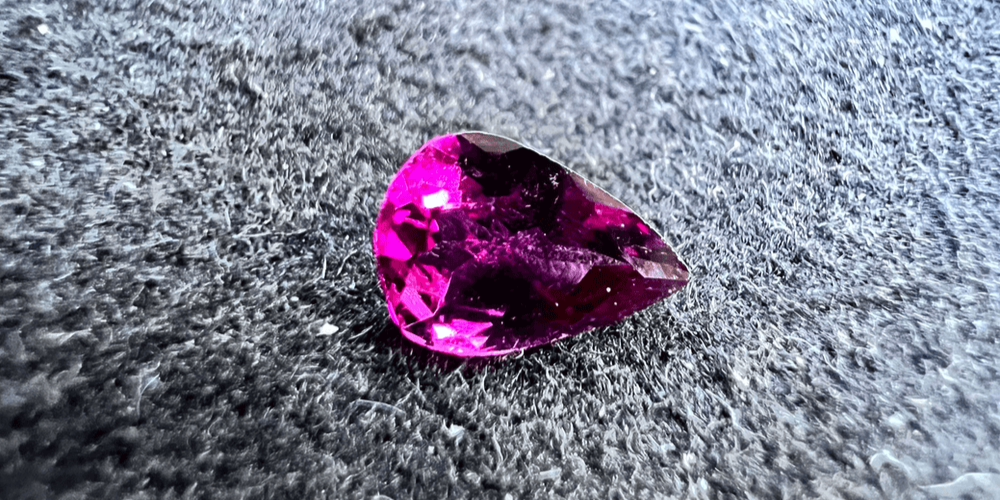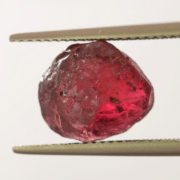Rhodolite: Properties, Uses and Benefits
Rhodolite: The Grape Gem!
Rhodolite, a member of the garnet family, is celebrated for its captivating raspberry and grape hues and enduring charm. With its deep tones evoking passion and elegance, Rhodolite has become a firm favourite with gem lovers and jewellery connoisseurs alike.
Discover the geological formation, raw beauty, global presence and metaphysical significance of this remarkable gem.

Rhodolite garnet: Table of contents
- Geological Formation of Rhodolite
- Rough Rhodolite – Raw Beauty Revealed
- Sources – The Global Scope of Rhodolite
- Historical Significance of Rhodolite – Through the Ages
- Metaphysical Properties of Rhodolite – Illuminating energies
- Varieties of Rhodolite
- Rhodolite colors
- Durability and Wearability of Rhodolite
- Rhodolite Enhancements – Preserving Natural Beauty
- Rhodolite Synthetic – Nature in the Laboratory
- Rhodolite Imitations – Discerning the Genuine
- Rhodolite care – Preserving natural beauty
Geological Formation of Rhodolite
Rhodolite, a member of the garnet group of minerals, forms under conditions of high pressure and is commonly found in metamorphic rocks such as schists and gneisses. Its creation involves the interaction of minerals under intense heat and pressure, leading to the formation of this magnificent gem deep within the earth’s crust.
Rough Rhodolite – Raw Beauty Revealed
The appeal of raw garnet crystals lies in their captivating visual appearance, enhanced by distinctive geometric shapes. Seen through the discerning eyes of gemologists, these uncut gems reveal fascinating structures, with two main shapes, the rhombic dodecahedron and the twenty-four-sided icosahedron, playing an essential role in their identification and appreciation.
Shape of the rhombic dodecahedron :
The visually striking shape of the rhombic dodecahedron is a characteristic feature of raw garnet crystals. Composed of twelve congruent rhombic faces, this symmetrical, well-defined polyhedron fascinates gemologists and gem enthusiasts alike. Recognizing this shape is a crucial identification criterion for garnet, offering valuable information on its unique crystalline arrangement and intrinsic properties.
Icosahedron shape :
Another visually intriguing manifestation found in raw garnet crystals is the icosahedron shape. This polyhedron has twenty-four faces, each composed of equilateral triangles. The icosahedron structure highlights the gem’s symmetry and crystallographic characteristics, enabling gemologists to distinguish and celebrate Garnet among its counterparts.
Sources – The Global Scope of Rhodolite
Rhodolite garnet is mined in various regions around the world, including Madagascar, Brazil, Sri Lanka, Zimbabwe and Tanzania. This global presence contributes to the gem’s colour variations and diverse characteristics, making Rhodolite a sought-after gemstone for jewellery creations.
Historical Significance of Rhodolite – Through the Ages
Although Rhodolite’s historical significance may not be as extensive as that of some gems, due to the ancient world’s limited ability to distinguish between different reddish gems, its exquisite raspberry hues have attracted attention.
The gem’s association with passion and elegance has made it a symbol of love and devotion, resonating with individuals who seek to express their feelings through its radiant beauty.
Metaphysical Properties of Rhodolite – Illuminating energies
Rhodolite is believed to possess metaphysical properties that evoke emotions such as love, compassion and devotion. Its deep, haunting hues are associated with the heart chakra, promoting emotional healing and nurturing relationships. This gem is thought to inspire harmony and balance in life.
Varieties of Rhodolite
Rhodolite has no varieties and is itself a variety of pyrope-almandin.
Rhodolite colors
Rhodolite’s colours cover a spectrum of rich raspberry hues, from soft pinks to intense reds. Its attractive berry colour is what earns it the name “Garnet Raisin”.
Durability and Wearability of Rhodolite
Rhodolite garnet offers excellent durability, with a hardness of 7 to 7.5 on the Mohs scale. This robustness ensures that Rhodolite can withstand daily wear while retaining its captivating sparkle and seductive charm.
Rhodolite Enhancements – Preserving Natural Beauty
Rhodolite is generally appreciated in its natural state and is not frequently enhanced. Its natural raspberry tones require no artificial treatment to shine brilliantly, making it a cherished gemstone that celebrates its innate beauty.
Rhodolite Synthetic – Nature in the Laboratory
Although natural Rhodolite is popular, synthetic Rhodolites created in laboratories have emerged. However, they are very rare on the market because the process itself is costly and generally reserved for much more precious and rare gems. Buyers need to be vigilant because many of the ‘synthetics’ on the market are imitations.
Rhodolite Imitations – Discerning the Genuine
As a sought-after gemstone, Rhodolite can encounter imitations that attempt to reproduce its striking appeal. The most common culprits are glass, cubic zirconia or garnet-glass doublets.
Buyers should exercise caution and source their gems from reputable suppliers to ensure they are acquiring genuine Rhodolite.
Rhodolite care – Preserving natural beauty
Caring for Rhodolite jewellery preserves its timeless beauty.
To preserve its brilliance, avoid exposing Rhodolite to aggressive chemicals and store it separately from other precious stones.
Gently clean Rhodolite jewellery with mild soapy water and a soft brush to preserve its elegance for generations.



Leave a Reply
Want to join the discussion?Feel free to contribute!